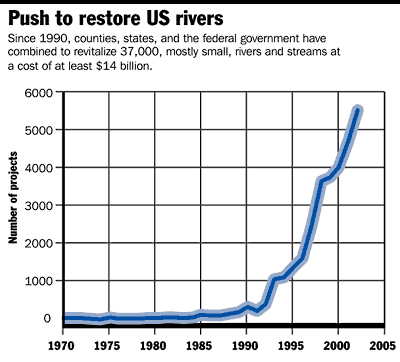| Friends of Alewife Reservation (FAR)
|
|
|
|
|
Restoring America's rivers - a model for Alewife from the Christian Science Monitor See the rest of the article, including photos, at http://www.csmonitor.com/2005/0512/p15s01-sten.html America's unheralded water cleanup
Visitors to Longdale Park in urban Atlanta may enjoy the little meandering stream that winds its tree-shaded way through the park without ever a clue that it used to be a buried metal pipe. That restoration - or "daylighting" - of Longdale's rotting, subterranean conduit is a modest environmental success story. It is also part of a far broader push to restore degraded rivers and streams nationwide, an effort whose enormous scope is only now being revealed by researchers who were shocked at its size. With little fanfare, counties, states, and the federal government have collectively spent an estimated $14 billion or more - at least $1 billion a year since 1990 - to restore rivers and streams to their natural condition, not including dollars spent on Goliath restoration projects like the Everglades. Ironically, the move to clean up America's unheralded rivers comes at a time when the condition of the nation's waterways overall is starting to deteriorate. "What we're seeing is a twofold phenomenon," says Andrew Fahlund, vice president for protection and restoration of American Rivers, an environmental group. "There's been great recognition of the value of healthy rivers and streams in our communities. But now we're at risk of backsliding from the progress we've made over 30 years." Better-known restoration efforts include ongoing cleanup of rivers flowing into Chesapeake Bay and dams being breached to restore Pacific salmon runs. Large restoration projects on the Kissimmee River, the Grand Canyon, and the Illinois and Mississippi rivers get most of the attention. But the bulk of the 37,000 projects since 1990 have involved smaller rivers that have had an outsized impact on the environment, according to the National River Restoration Science Synthesis, a cooperative two-year study by researchers at 11 universities. The NRRSS results were unveiled in the journal Science last month. "When I started the project, I thought we might find several thousand of these projects," says Emily Bernhardt, professor of biology at Duke University, who participated in the study. "The scale of what we found was amazing. There's been exponential growth." That finding is tempered by growing signs that the nation's rivers are getting dirtier overall - after decades of getting cleaner, the same study notes. From about 1973 to 1998, rivers and lakes in the United States were getting cleaner, but that's now reversed itself, according to American Rivers, which helped organize the new study. Examples: More than a third of US rivers are listed as polluted or impaired. Extinction rates of freshwater fish are about five times the level of land animals. Withdrawals of freshwater from rivers for agricultural and other uses is so extreme in some regions that the rivers no longer reach the ocean all year long, the study says. A sewer problemAdding to the challenge: aging sewage-treatment facilities that, without a renovation costing $320 billion to $450 billion, could in 2016 return US rivers to the way they looked - and smelled - in the 1970s, according to a 2002 report from the Environmental Protection Agency. Water quality is now beginning to decline for several reasons, Mr. Fahlund says. The Clean Water Act did a good job initially of cutting pollution from "point sources," the big reason for improvements over 30 years. But at the same time, nonpoint sources - runoff from parking lots, streets, agriculture - were getting worse. Today, nonpoint pollution has in many places surpassed those earlier gains. On the other hand, the threat of costly and onerous environmental penalties has driven the increase in river and stream restoration, Fahlund says. Federal and state funds have been ladled out for larger projects. Smaller, private "mitigation funds" - compensation paid by developers in exchange for environmental degradation from their projects - have financed the huge growth in river restoration. In the Southwest, much of the focus is on saving endangered species like the humpback chub, while in Chesapeake Bay the focus is on cleaning up excess sediment and nutrient pollution. In the Southeast, meanwhile, developer "mitigation credits" are the major propellant. Slightly more than half of the projects - about 20,000 - are in the Pacific Northwest. One of those projects can be found in an isolated region of Idaho. For millenniums, spawning chinook salmon found their way up the Columbia and its tributary, the Red River, a modest 50-foot-wide tributary that once wound its way in serpentine coils across mountain meadows of north central Idaho. 
SOURCE: NATIONAL RIVER RESTORATION SCIENCE SYNTHESIS; SCOTT WALLACE - STAFF See the rest of the article, including photos , at http://www.csmonitor.com/2005/0512/p15s01-sten.html |